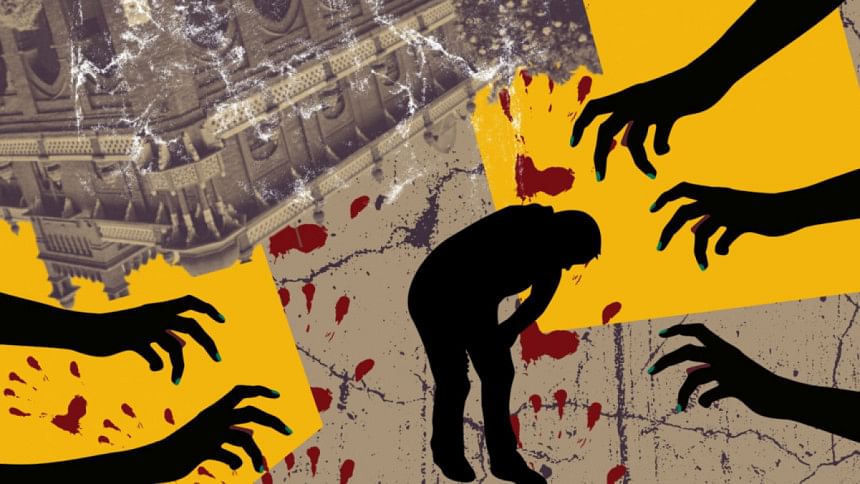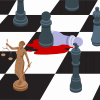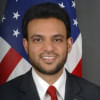Mob violence: Causes, consequences, and pathways to justice

On August 5, 2024, Bangladesh witnessed a seismic political shift with the resignation of Prime Minister Sheikh Hasina following months of youth-led protests. However, the hope for democratic renewal has been overshadowed by an unprecedented wave of "mob violence." Between August 2024 and March 2025, vigilante attacks claimed 119 lives and injured 74 individuals, while 2024 alone recorded 179 deaths—the highest annual toll in a decade, according to the Human Rights Support Society (HRSS). The Daily Star's editorial on April 6, 2025, "Why can't 'mob violence' be contained?" demands urgent introspection.
The term "mob violence" in Bangladesh encapsulates three overlapping phenomena. First, politically motivated lynchings have dominated the post-Hasina era, with over 75 percent of killings between August 2024 and March 2025 targeting Awami League affiliates, including former student leaders and local officials. Second, communal vigilantism has surged. Third, crime-driven retribution accounts for 69 percent of incidents, exemplified by the March 2025 lynching of Riyad, an Uber driver in Dhaka, over false accusations of mugging. While the label "mob violence" broadly captures collective brutality, it risks oversimplifying the interplay of politics, communal hatred, and institutional failure driving these acts.
The collapse of institutional trust lies at the heart of this crisis. Decades of politicised policing and judicial inertia have eroded public faith in governance. A 2024 survey by the Manabadhikar Shongskriti Foundation (MSF) revealed that 72 percent of Bangladeshis distrusted the police to address crimes promptly. Post-Hasina, 30 percent of police positions became vacant, and 450 of 639 police stations became nonfunctional after many were attacked.
Compounding this institutional decay is the role of digital amplification. Social media's rapid spread of rumours has proven lethal. On March 3, 2025, a fake loudspeaker announcement in Chattogram falsely accusing a man of child abduction triggered a mob killing. Cognitive psychology explains this as group dynamics overriding individual rationality. A similar incident occurred in March 2025 at Dhaka University—Tofazzal Hossain, a mentally ill man falsely accused of theft, was lynched.
Historical legacies of vigilantism further normalise violence. Rural dispute-resolution systems like shalish (village councils) have long sanctioned extrajudicial punishments. Urbanisation has fused these practices with political violence, exemplified by the January 2025 Narsingdi incident, where two brothers were beaten to death over a minor auto-rickshaw fare dispute.
The August 2024 uprising led to the dismantling of many law enforcement-related infrastructure, creating a security vacuum. Police retreated from the streets, fearing reprisals, enabling mobs to operate unchecked. Robbery cases in Dhaka surged by 69 percent year-on-year in January 2025, reflecting public desperation and economic difficulties.
Gender and communal tensions have further fuelled the crisis. The Magura child rape case in March 2025 sparked nationwide protests, which devolved into arson attacks on the household of the accused. Meanwhile, communal violence allegedly displaced many minority families in the post-Hasina period, with attacks often conflating political vendettas.
Economic despair compounds these issues. Poverty-stricken regions like Khulna allegedly saw numerous minority homes destroyed in mob attacks linked to unemployment and inflation.
Restoring institutional legitimacy must begin with police reforms. Addressing 30 percent staffing shortages and retraining officers in de-escalation tactics are critical. Prosecuting attackers of law enforcement is equally urgent—225 officers were assaulted between September 2024 and February 2025 alone. Judicial overhaul is also imperative. Fast-track courts for mob violence cases could reverse the current trend, where only 15 percent of 2024 cases resulted in convictions.
Tackling root causes requires economic and social interventions. Poverty alleviation programmes in high-violence areas like Khulna and Satkhira could mitigate desperation-driven crimes. Partnering with tech firms like Meta and TikTok to flag incendiary posts, as outlined in Dhaka Police's 2025 advisory, would counter misinformation.
Community-led initiatives offer promise. The MSF's 2024 pilot programme in Rajshahi reduced "mob violence" by 40 percent through dialogues in mosques, schools, and media campaigns. Mobilising student leaders from the anti-Hasina protests to publicly condemn vigilantism could leverage their moral authority for peace.
However, militarised crackdowns like Operation Devil Hunt—which saw over 1,500 arrests between September 2024 and February 2025 and alleged custodial deaths—risk replicating past authoritarian abuses. Transparent, civilian-led policing must replace such heavy-handed tactics.
Bangladesh's mob violence epidemic is not a law-and-order issue but a crisis of governance, trust, and economic justice. The interim government's rhetoric must translate into action: rebuilding institutions, prosecuting perpetrators, and addressing systemic inequality. As activist Nur Khan Liton asserted, "Without the rule of law, there is no way out." Failure to act risks more deaths due to mob activity in future, entrenching a culture of impunity. The time for accountability is now.
Zakir Kibria is a writer and policy analyst. He can be reached at [email protected]
Views expressed in this article are the author's own.
Follow The Daily Star Opinion on Facebook for the latest opinions, commentaries and analyses by experts and professionals. To contribute your article or letter to The Daily Star Opinion, see our guidelines for submission.

 For all latest news, follow The Daily Star's Google News channel.
For all latest news, follow The Daily Star's Google News channel. 










Comments